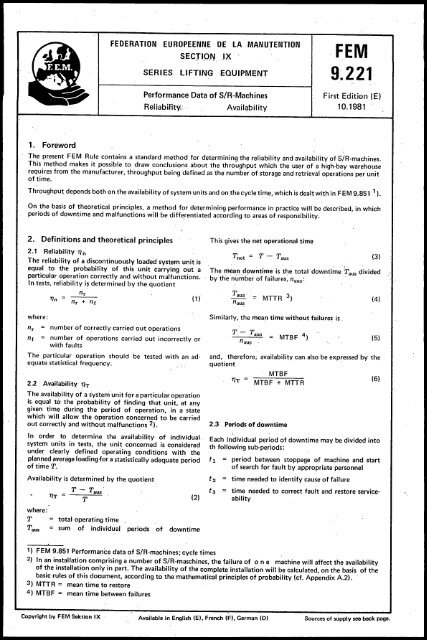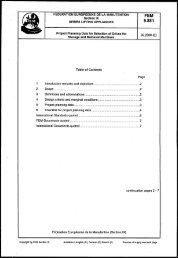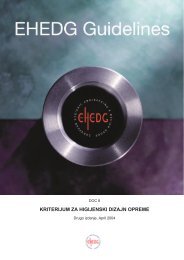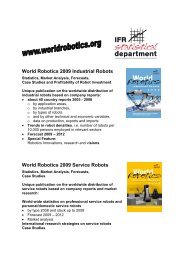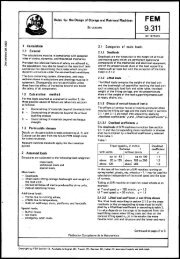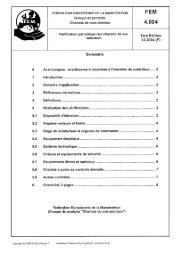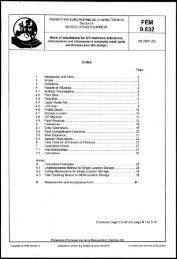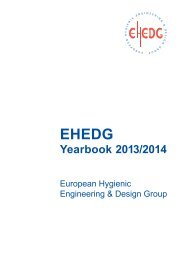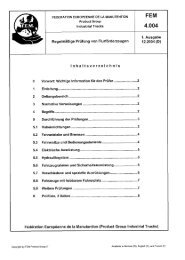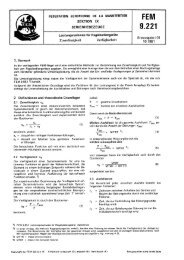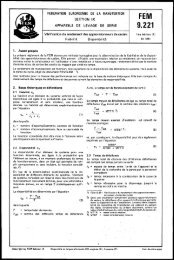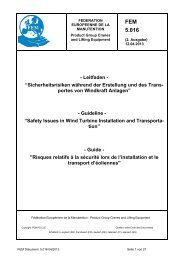9.221·
9.221·
9.221·
You also want an ePaper? Increase the reach of your titles
YUMPU automatically turns print PDFs into web optimized ePapers that Google loves.
FEDERATION EUROPEENNE DE LA MANUTENTION<br />
SECTION IX .<br />
SERIES LIFTING EQUIPMENT<br />
Performance Data of SIR-Machines<br />
ReliabiHty:<br />
Availability<br />
FEM<br />
9.221·<br />
First Edition (E)<br />
10.1981<br />
1. Foreword<br />
The present FEM Rule contains a standard method for determining the reliability and availability of SIR-machines.<br />
This method makes it possible to draw conclusions about the throughput which the user of a high-bay warehouse<br />
requires from the manufacturer, throughput being defined as the number of storage and retrieval operations per unit<br />
of time.<br />
Th·roughput depends both on the availability of system units and onthe cycle time, which is dealt with in FEM 9.851 1).<br />
. .<br />
On the basis oftheoretical principles, a method for detE:lrmining performance in practice will be described, in which<br />
periods of downtime and malfunctions will be differentiated according to areas of responsibility.<br />
2. Definitions and theoretical principles<br />
2.1 Reliability l1n<br />
The reliability of a discontinuously loaded system unit is<br />
equal to the probability of this unit carrying out a<br />
particular operation correctly and without malfunctions.<br />
In tests, reliability i~ determined by the quotient<br />
where:<br />
nr<br />
number of correctly carried out operations<br />
nf = number of operations carried out incorrectly or<br />
with faults<br />
The particular operation should be tested with an adequate<br />
statistical frequency.<br />
22 . Availability 71T<br />
The availability ot" a system unit for a particular operation<br />
is equal to· the· probability of finding that unit, at any<br />
given time during the period of operation, in a state<br />
which will allow the operation concerned to be carried<br />
out correctly and without malfunctions 2).<br />
In order to determine the availability of individual.<br />
system units in tests, the unit concerned is considered<br />
under clearly d.efined operating conditions with the<br />
planned aver~geloading·fora statistically adequate period<br />
of time T.·<br />
Availability is determined by the quotient<br />
where:<br />
T<br />
Taus<br />
l1T<br />
(1)<br />
T - Taus·<br />
T (2)<br />
total operating time<br />
sum of individual periods of downtime<br />
This gives the net operational time<br />
T net = T - Taus<br />
. ..<br />
The mean downtime is the total downtime Taus divided<br />
by·the number of failures; n aus :<br />
T .<br />
~ = MTTR 3)<br />
naus .<br />
Similarly, the mean time without failures is.<br />
T.:- Taus = MTBF 4)<br />
nauṡ .<br />
and, therefore; availability can also be expressed by the<br />
quotient<br />
l1T<br />
MTBF<br />
MTBF + MTTR<br />
(6)<br />
2.3 Periods of downtime<br />
Each individual period of downtime may be divided into<br />
th following sub-periods:<br />
t1<br />
(3)<br />
(4)<br />
(5)<br />
period between stoppage of machine and start<br />
of search for fault by appropriate personnel<br />
time needed to identify cause of failure<br />
time needed to correct fault and restore serviceability<br />
1) FEM 9.851 Performance data of SIR-machines; cycle times<br />
2) In an installation comprising a number of S/R-maschines, the failure of 0 n e machine will affect the availability<br />
of the installation only in part. The availability of the complete installation will be calculated, on the basis of the<br />
basic rules of this document, according to the mathematical principles of probability (cf. Appendix A.2).<br />
3) MTTR = mean time.to restore<br />
4) MTBF = mean time between failures<br />
Copyright by FEM Sektion IX Available in English (E), French (F), German (D) Sources of supply see back page.
BagBi 2 FEM 9.221<br />
3. Practical application<br />
3:1 Perlorrtlance test<br />
The throughput of a system unit may be checked by<br />
performance tests. Cycle times are determined as describedin<br />
FEM 9.851.<br />
Tests for determining reliability and availability are<br />
spread over a certain reference.period, which should not<br />
be too short. A test of this type may also be carried out<br />
for checking agreed performance figures. In this case,<br />
the beginning and end of the test period should be<br />
agreed between the user and supplier. The duration<br />
should be between 1 day and 1 working week, according<br />
to the size of the installation.<br />
During the tests, it should be ensured that the machines<br />
are subjected to working stresses within the designated<br />
limits, as regards both the frequency and spectrum of<br />
the loads to be stored, which should be within the limits<br />
of the load spectrum for which the machine was designed<br />
(cf. F EM 9.512 5), as well as an even distribution<br />
of storage points over the whole warehouse such as used'<br />
as the basis for calculating cycle times (cf. FEM 9.851).<br />
Stress programmes, such as are found in the filling of<br />
a store .or during peak pedo"ds, are not suitable for this<br />
purpose.<br />
When the record is' evaluated, the periods of downtime<br />
mentioned in Section 2.3 may be determined as<br />
follows:<br />
B A<br />
C B<br />
D C<br />
3.3 Allocation to areas of responsibility<br />
When tests have been carried out for checking an agreed<br />
performance figure, it is necessary to ascribe the causes<br />
and sub-periods of downtime to individual areas of responsibility,<br />
so that, on the one hand, the user can<br />
clearly seeH the S/R-machine's performance is as agreed,<br />
and~ on the other, that the supplier is not attributed<br />
with downtime and periods of malfunctioning for<br />
which he cannot be held responsible. This assessment<br />
should be carried out by the user and supplier together.<br />
When an SIR-machine is assessed, downtime should not<br />
be taken into account when the causes are, for instance:<br />
errors in operation,<br />
errors in entering data,<br />
faulty pallets or load units,<br />
manual storage of goods in automatic installtaions,<br />
maintenance,<br />
etc.<br />
For the remaining technical faults, a distinction must be<br />
made between the sub-periods: t1' t2 'and t3<br />
The period t 1 is determined by the user exclusively and<br />
cannot be ascribed to the supplier.<br />
The period t 2 is dependent upon causes which.may be<br />
attributed both to the user and to the supplier. The<br />
user's area of responsibility includes, for instanCe, the<br />
training and suitability of maintenance personnel, the<br />
availability of the correct tools, etc. The supplier can<br />
design the system from the outset so that faults can be<br />
identified more easily.<br />
If, in certain cases, time is taken to ascertain the causes<br />
of failures in detail, this should not be included as<br />
downtime.<br />
The period t3 may be ascribed to the supplier on the<br />
precondition that<br />
any replacement and wearing parts needed for<br />
repairs are kept in stock by the user in accordance<br />
with the contractual agreements,<br />
the maintenance team has the training and the<br />
equipment to complete the work within an acceptable<br />
period.<br />
3.4 Evaluation<br />
An evaluation sheet such as that in From 2 7) may be<br />
used for this purpose.<br />
3.4.1 Reliability<br />
The number of cycles recorded in the test certificate<br />
gives the reliability by the application ()f formula (1).<br />
If a distinction is to be made on the basis of areas of<br />
responsibility, for instance that of the supplier, only the<br />
number of the incorrect operations for which he must<br />
accept responsibility is to, be entered (nfd:<br />
7]nL<br />
n r<br />
3.4.2 Availability<br />
The total downtime is arrived at by using the data from<br />
the test certificate in the formula'<br />
T ausL<br />
n<br />
~<br />
i=l<br />
DoWJJtirne .is ca!cl,llated. ,separately for each. area and<br />
marl
FEM 9.221' Pag~ 3<br />
The dQwntime ascribed to the supplier is related to the<br />
net operating time, T;'et (cf. formula· (3) ), and determined<br />
by formula (10):<br />
l1TL<br />
It should be borne in mind that operating time for in·<br />
dividual SIR-machines can also be recorded for indi·<br />
vidual SIR-machines, even if the total system is considered<br />
as malfunctioning 8). In calculating the net<br />
operating time in such cases, only the periods of downtime<br />
and malfunctions of the machine itself may be<br />
deducted .from the total operating time, and not the<br />
downtime of the complete system, especially when deciding<br />
whether contractual committments have been<br />
kept.<br />
·3.4.3 Throughput<br />
Tnet +<br />
T ausL<br />
(10)<br />
Throughput may be calculated usin·g the cycle time as<br />
determined in FEM 9.851 and the figures for availability<br />
found by; the above method. High availability figures<br />
and short cycle times have a positive influence on<br />
throughput. To a certain extent, the two figures may<br />
be' used to compensate for each other.<br />
If, for instance, there is a shorter cycle time for the<br />
installation during the test than contractually agreed,<br />
the availability requirement may be considered to have<br />
been met if the agreed throughput has been reachEJd.·<br />
4. Standard values<br />
Due to the fact that operator training is not complete<br />
during the first months following commissioning of the<br />
SIR-machine and that the continued operation of the<br />
SIR-machine can reveal malfunctions or inaccuracies<br />
which are not always detectable during the works acceptance<br />
and commissioning, the supplier can guarantee a<br />
throughput rate wich increases with time.<br />
After the first three months following the end of commissioning,<br />
availability is generally as high as 90 %, after<br />
a further three months, i. e. 6 months. after the end of<br />
commissioning, it can be as high as 96 %..<br />
Particularly complex installations or especially difficult<br />
working conditions may affec~ these periods and availability<br />
figures.<br />
The above figures for availability are made on the<br />
'following assumptions: .<br />
a) The installation is operated exclusively by trained and<br />
experienced personnel.<br />
b) Experience shows that downtime occurs more frequently<br />
when normal preventive mainter:'!ance is not<br />
carried out as it should be. The user must, therefore,<br />
ensure that preventive maintenance is carried out<br />
according to the instructions of the supplier~ It is recommended<br />
that operating personnel become acquainted<br />
with the technical details' of the installation<br />
by assisting in the erection and commissioning of the<br />
SIR-machine;, thus enabling them to correct malfunctions<br />
occurring later on their own.<br />
c) Inspection and maintenance are not taken into<br />
account when calculating availability.<br />
d) Replacement and wearing parts must be available on<br />
site according to the recommendations of the supplier.<br />
8) E. g. in the case of incorrect comma~ds from a superordinate computer
t>agll4 FEM 9,221<br />
A pp END I X A. 1<br />
Calculation example<br />
·6 months ·after the commissioning of an installation, one SIR-machine was given an<br />
.pperaUonal test for a period of one week.<br />
During the 5 days of single-shift operation, the machine worked a total of T= 37.3 hrs 1).<br />
A total downtime of Taus = 2.1 hrs was recorded but, of this,only T ausL = 1.6 hrs could<br />
be attributed to the supplier's area of responsibility (the other 0.5 hrs were due to factors<br />
unrelated to the SIR-machine). The availability may therefore be found by applying<br />
formula (9) and using the net operating time<br />
to give<br />
T net = T - Taus = 37.3 ,.... 2.1 = 35.2<br />
1)TL<br />
T net +<br />
Tnet ·<br />
T ausL<br />
35.3<br />
35.2 + 1.6<br />
0.9565 or 95.65 %<br />
As this result is lower than the contractually agreed result of 96 %, the machine's throughput<br />
must also be taken into account.<br />
Compared with the agreed 25 cycles per hour (mean cycle time 144 seconds), a mean<br />
cycle time of 133 seconds was recorded 2), i. e. 27 single cycles per hour. As this is 8 %<br />
higher than agreed, the machine does meet the availability requirement despite the fact<br />
that the agreed figure for availability has not been reached. The machine may, therefore,<br />
be accepted.<br />
1) . !aking ir:Jtoaccount the condition given in the last-paragraph of Section 3.4.2<br />
2) Cf. FEM 9.851 Performance data of S/R-maschines; cycle times
FEM 9.221 ,'Page 1)<br />
A pp 'e' NO I X A.2<br />
.0":: .<br />
Availability in installations with a number of machines<br />
In order to be able to draw conclusions about availability in an installation with a number of SIR-machines,<br />
many peripheral factors must be known, which relate to the exact degree of dependence of the individual units<br />
upon each other and the influence which the failure of one machine will have on the complete operation.<br />
For ex'ample, in the case that one ~achine fails completely/for a certein period of time, if the other machines ca'l)<br />
,take over the operation, the availability of the complete system l1Tges is only reduced if all the machines are<br />
inoperative at the same time. The individual availabilities, l1Tl, l1T2, ... are used to determine the total availability<br />
by the following formula:<br />
i. e. with x machines having the same availability<br />
l1Tges = 1 - (1 -11T1) . (1 -l1T2) ......<br />
l1Tges = 1 - (1 - riT)X<br />
If the machines considered are indeed fully independent and interchangeable, the total availability is a mathematically<br />
exact value, which is also produced when the machines are checked in tests as a complete system with<br />
one goods-in and goods-out point and which may also be used in superordinate calculations of avalability.<br />
, In practice, greater importance is sometimes attaChed to determining the influence which the availability of<br />
one element in the system has on the complete installation. For this purpose, a corrected availability figure.<br />
l1Tcor' may be used, which is calculated using not the complete downtime of a machine but only that proportion<br />
which actually, affects operation of the installation:<br />
l1Tcor<br />
T net<br />
T net + fear . Taus<br />
If, for instance, one of two machines in an installation can assume 60 % of the total throughput in the case of a<br />
malfunction in the other machine 0. e. total performance is reduced by40 %), the correction factor is:<br />
fear = (1 0.6) = 0.4<br />
and the corrected availability is<br />
l1Tcor<br />
T net<br />
T net<br />
+ 0.4 . Taus<br />
An assessment of the relative importance of individual parts of an installation is thus possible..<br />
Both methods of calculation show clearly, however, that even low availability figures for individual system units<br />
pose no problems for the complete installation if, in the case of a malfunction. it is possible to continue operating<br />
the system by appropriate user strategy and by the skillful combination of system units.<br />
"<br />
"
--<br />
... ;<br />
..<br />
J?,erfQJ!J1larie~'Datatof~SJR~i'v1~thin'eS'i .<br />
:':,R~!i,~.QH~W<br />
Pq~~il~9.Hit¥.<br />
FEM 9.221<br />
'lb'gg~d;fu'V;:'tr(;!', .<br />
·Nllm~;·······:····,······· ~<br />
Number>:of ~~oragp ..operations , . . . . . . . . . . Malfl/lilctions: .<br />
• Number.of retrieval, op~rations. . . . . . . . . . . Malf4flctions .<br />
:iEime<br />
.Star1,of St<br />
'"Et---t---t---I-----'---'f---f--------------------------l<br />
E'<br />
o'""<br />
~,t--'--t----t-----+---+-----+----------------------------I<br />
.c<br />
I-
Performance- Data-of S/R~Machines<br />
1,E,vaiuatioifplrorrri;,'; FEM 9.221<br />
: SUp'pli,er," -<br />
- Machine,data<br />
No.<br />
Type<br />
SWL (kg) .'<br />
Order no.<br />
Q)<br />
:J '"<br />
...<br />
References<br />
Prepared by the Committee "Storage/retrieval-machines and stacker cranes" of Section IX<br />
of the Federation Europeenne de la Manutention (FEM) .<br />
Secretariat:<br />
Sekretariat der FEM Sektion IX<br />
c/o VOMA<br />
Fachverband Fordertechnik und Logistiksysteme<br />
Postfach 71 08 64<br />
0-60498 Frankfurt<br />
Available from the above secretariat or from the following national committees of FEM:<br />
Belgium<br />
Comite National Beige de la FEM<br />
Fabrirnetal<br />
Rue des Drapiers 21<br />
B-1050 Bruxelles<br />
Tel: +32-2-7067982<br />
Fax: +32-2-706 7988<br />
Info@fabrimetaLbe<br />
wwwJabrimetaLbe<br />
Luxembourg<br />
Comite National Luxembourgeois de la FEM<br />
Federation des Industriels Luxembourgeois<br />
Groupement des Constructeurs et Fondeurs du<br />
Grande-Duche de Luxembourg<br />
Boite Postale 1304<br />
Rue Alcide de Gasperi 7<br />
L-1013 Luxembourg<br />
Tel:+35-2-435366-1<br />
Fax:+35-2-43 2328<br />
fedil@fedil.lu<br />
wwwJedil.lu<br />
Finland<br />
Finnish National Committee of FEM<br />
Federation of Finnish Metal, Eng. and Electrotechnical<br />
Industries (FIMET)<br />
Etelaranta 10<br />
FIN-00130 Helsinki<br />
Tel: +358-9-192 31<br />
Fax: +358-9-624462<br />
www.met.fi<br />
Netherlands<br />
Nederland Nationaal Comite bij de FEM<br />
Vereniging FME<br />
Postbus 190. Boerhaavelaan 40<br />
NL-2700 AD Zoetermeer<br />
Tel: +31-79-35311 00<br />
Fax: +31-79-353 1365<br />
com@fme.ne<br />
www.fme.nl<br />
France<br />
Comite National Fran9ais de la FEM<br />
Syndicat des industries de materiels<br />
de manutention (SIMMA)<br />
39/41 rue Louis Blanc - F-92400 Courbevoie<br />
cedex 72 - F-92038 Paris la Detense<br />
Tel: +33-1-4717 6321<br />
Fax: +33-1-4717 6260<br />
Mtps@wanadooJr<br />
www.mtps.org<br />
Norway<br />
Norwegian FEM Groups<br />
Norsk Verkstedsindustris<br />
Standardiseringssentral NVS<br />
Box 7072 / Oscars Gate 20<br />
Majorstua<br />
N-0306 Oslo<br />
Tel: +47-22-590-000<br />
Fax: +47-22-590-001<br />
www.tbLno
Germany<br />
Deutsches Nationalkomitee der FEM<br />
VDMA<br />
Fachverband Fordertechnik<br />
Postfach 71 08 64<br />
D-60498<br />
Lyoner Str. 18<br />
D-60528 Frankfurt<br />
Te:+49-69-66031508<br />
Fax: +49-69-66031496<br />
Foerd@vdma.org<br />
www.vdma.org<br />
Portugal<br />
Comissao Nacional Portuguesa da FEM<br />
ANEMM<br />
Estrada do Pa


